Starting a company is an exhilarating ride. With ideas flying around, there’s definitely excitement about getting a product out soon. There’s probably the thrill of building something new and the excitement of launching a product the world’s never seen before. With so many things in mind, the path forward can often look a bit, well, foggy.
Even the best ideas need a clear, strategic plan to take them from daydream to delivery. It’s not enough to know what you want to build; you also need a solid way to get there. One that’s reliable but flexible, focused yet adaptable. That’s where product roadmaps come in. You want your roadmap to do more than just lay out the journey. It should clarify your goals, keep your team aligned, and show everyone, including investors and customers, that you’re building with purpose.
Of course, not all roadmaps will serve the same purpose. Some have a very structured timeline, while others are more about the long-term goals and broader vision, showing stakeholders the real “why” behind each step. There are product roadmap examples centered on features, customer needs, and even a few that just help you keep all your products in sync when things start getting complex.
What we want to do with this blog is break down the most common roadmap types and give you a peek at how each one can serve as a stepping stone toward product success. Hopefully, you might just find the roadmap that’s exactly what your company’s been missing.

Timeline-Based Roadmap
This product roadmap example, the classic, structured approach, is for those of us who need to know when things are happening, plain and simple. Picture it as your company’s “master calendar,” laying out a clear sequence of milestones, features, and phases, each with its delivery date.
A timeline-based roadmap can be ideal if you’re working with clients and stakeholders who need to set delivery dates. In a scenario where you’ve promised a major update or release to your customer base by the end of Q2, this roadmap ensures everyone’s on the same page about when that work needs to be done. It provides a structured backbone that can help prevent scope creep, offering your team (and you) the confidence that deadlines will be met and resources allocated efficiently.
Just know that timelines can shift. Unexpected bugs, new feature requests, or changes in market conditions can all throw off the original schedule, which means you’ll likely need to adjust and communicate these changes along the way. So, while the timeline-based roadmap helps set expectations, it’s also about managing them if things don’t go quite as planned.
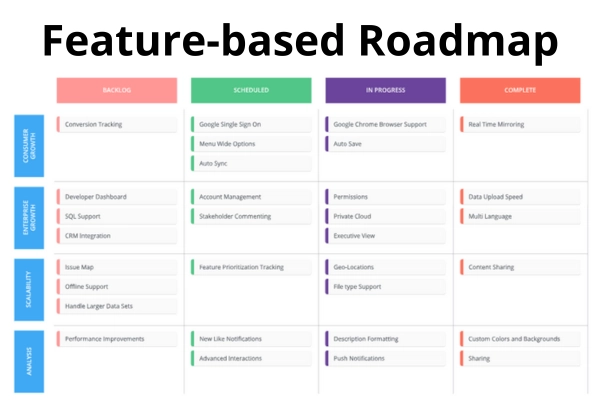
Feature-Based Roadmap
This is one of the product roadmap examples that is focused on what you’re delivering rather than when you’ll deliver it. The Feature-based roadmap is about “what’s next” for your product, mapping out specific features and functionalities that your team plans to develop.
This is particularly helpful if your product is in a phase where adaptability is key. Maybe you’re looking to roll out features that respond quickly to customer feedback or market needs—this roadmap lets you keep your team focused on delivering value without feeling boxed in by strict time constraints. Instead of aligning with specific dates, you’re aligning with the goals of what the product needs to become to serve your users better.
Of course, without time-bound commitments, this roadmap can sometimes make it harder for stakeholders to gauge when these features will land. If you’re dealing with clients or investors who crave concrete timelines, you’ll want to be transparent about the focus on functionality rather than delivery dates. But for fast-moving teams, this roadmap style offers room to breathe, adapt, and make sure that each feature is delivered just right.
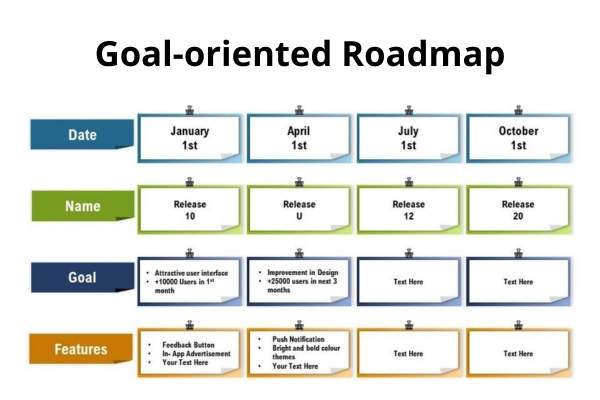
Goal-Oriented Roadmap
One of those examples that puts the focus squarely on why you’re building certain features instead of what or when. This roadmap is less about specific deliverables and more about strategic objectives: Mapping out the high-level goals that drive each initiative. It’s ideal if you’re trying to ensure that everything you’re building aligns with the broader company vision.
This roadmap type is especially useful for founder-led teams or leadership groups that need to keep everyone motivated by the big picture. Say you’re working on an innovative product that requires team-wide alignment with some bold, strategic outcomes. This roadmap lets you communicate not just the details but also the impact, allowing your team and stakeholders to understand exactly why each feature or project matters.
The challenge here is that this roadmap style can sometimes feel a bit too abstract for those working on the day-to-day execution. Developers or project managers might need more concrete steps to translate these goals into actionable tasks. It would be wise to pair it with a more granular breakdown for the team.
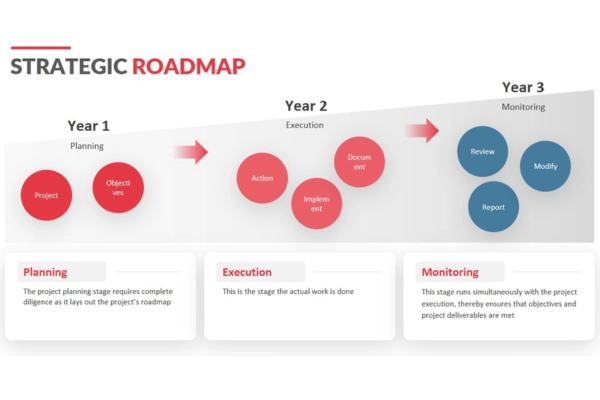
Strategic Roadmap
It might sound too similar to the goal-oriented roadmap, but there are some key differences. Unlike the goal-oriented one, which zeroes in on achieving specific, measurable outcomes, the strategic roadmap is about connecting each product initiative with the company’s high-level ambitions. Meaning things like entering new markets, evolving the brand, or reaching industry leadership status.
If you’re looking to align your product with multi-year objectives, the strategic roadmap is ideal for guiding the big-picture discussions and decisions at the leadership level. It’s less about hitting specific short-term targets and more about setting a direction that every product initiative can support over time.
However, because it’s focused on vision and direction, the strategic roadmap doesn’t provide specific, measurable targets or timelines like the goal-oriented roadmap. For teams working on daily tasks, the strategic roadmap might not be the best option.

Portfolio Roadmap
If your company manages a range of products or multiple teams, the portfolio roadmap is like your bird’s-eye view, letting you see how resources, timelines, and priorities stack up across everything you’re working on. Rather than focusing on a single product’s progress, this roadmap consolidates the development of all products, offering a strategic snapshot for leaders managing a full portfolio.
It is particularly useful for companies with diverse offerings or complex project structures. Imagine you’re managing two or three product lines that each serve different audiences or markets. The portfolio roadmap lets you check at a glance how each product is progressing and how resources are being allocated. Very useful for spotting overlaps, aligning timelines, or reallocating resources where they’re needed most.
That said, the focus on high-level coordination can make it challenging to manage the details of each product. For product managers or developers focused on execution, this roadmap won’t dive into specific features or goals for any single product. Instead, it works best when paired with a more detailed roadmap for each product.
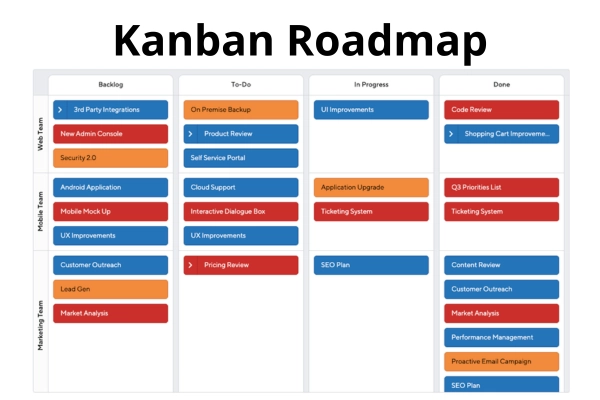
Kanban or Agile Roadmap
One of the more flexible product roadmap examples. Perfect for teams that prioritize ongoing work and iterative progress over rigid timelines. Rather than mapping out specific deadlines or long-term goals, this roadmap organizes tasks into categories like “To-Do,” “In Progress,” and “Completed,” giving the team a real-time view of what’s currently being worked on and what’s up next.
This style is a go-to for Agile teams that thrive on flexibility, allowing them to adapt quickly to shifting priorities or new needs. Picture your team working on refining features based on frequent user feedback. This roadmap gives them the space to respond immediately without having to adjust to a strict schedule.
Because it’s centered around ongoing tasks, the Kanban or Agile Roadmap can also lack some of the long-term vision and strategic depth that stakeholders might need. To keep everyone aligned, it’s often paired with a higher-level roadmap that provides broader direction while this one keeps the team grounded in the present.

Release Plan Roadmap
You will turn to this roadmap when you need a clear, step-by-step plan for delivering specific updates or features to your users. The release plan roadmap zeroes in on upcoming releases (obviously) and what each will include. With this roadmap, you’re outlining what’s in development but also when users can expect to see it.
A great way to communicate deliverables to stakeholders or customers in a straightforward way. Say your team is working on a major version update or a series of new features to be released over the next few quarters. The release plan roadmap maintains the order, ensuring that each release is well-coordinated and that everyone knows what’s included.
While it is a more tactical approach, it’s best used alongside a higher-level roadmap that shows why each release matters in the grand scheme of things.
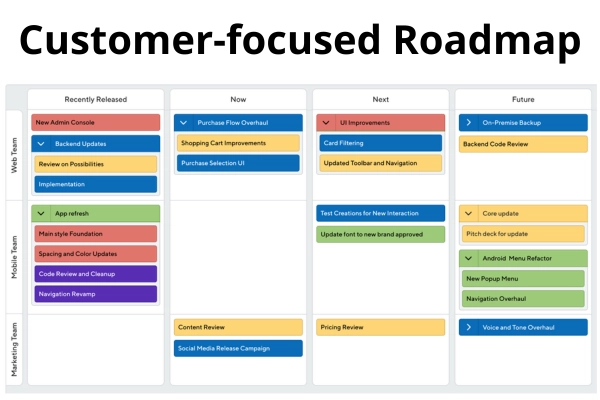
Customer-Focused Roadmap
Let’s go all-in on prioritizing features and updates based directly on what your customers are asking for. That is why we have the customer-focused roadmap. While others may consider customer needs, this one places them front and center, letting user feedback fully drive the development process.
If your product thrives on high user engagement, or if you’re in a market where customer loyalty is essential, this roadmap keeps you connected with your audience by making sure that each update addresses something they’ve been asking for. Your team will be working through a list of top-requested features or resolving the most common pain points, all consistently guided by customer priorities.
That said, if you focus so closely on direct user requests, there’s a risk of losing sight of the larger strategic direction. Without balance, it can lead to a reactive, feature-driven approach that doesn’t always align with the company’s long-term goals.
Which Product Roadmap Example Fits You?
Each type of roadmap is like a different tool in your toolkit, letting you highlight specific areas when you need them. You don’t need to commit to a unique tool when you are building something. Well, the same goes for product roadmap examples. When you combine these approaches, you give yourself a multifaceted view, helping you capture the details of the here and now and the aspirations of where you want to go.
CodingIT is here to help you build. Providing you with these tools and others you might have not considered yet. Our blog is full of entries that can help you navigate the challenges of your business, offering expertise that’s rooted in practical experience and strategic insight. Reach out, and let’s start building a roadmap that’s as dynamic and ambitious as your product vision.
